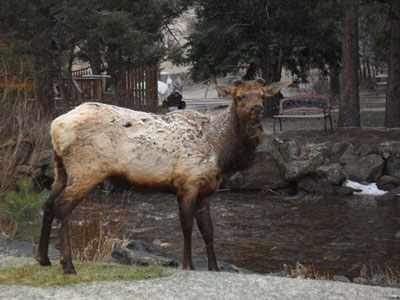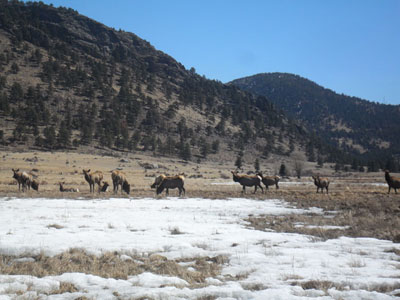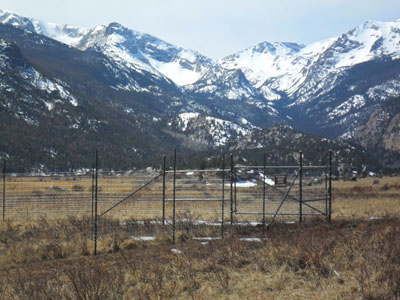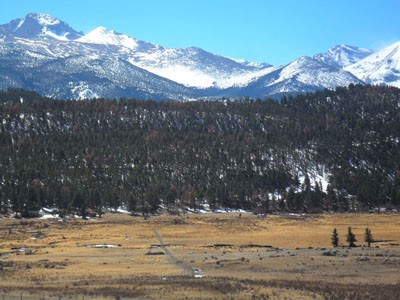
Enclosures manage elk, protect vegetation
ESTES PARK, Colo. — Vast meadows, snowy mountain tops that soar sky-high and hilltop views worthy of screensavers are all what tourists expect to see when they enter Rocky Mountain National Park.
What don’t they expect to see?
Large man-made fences with “keep gates closed” signs plastered on their sides. Due to the elk overpopulation in the area, however, these enclosures have become the answer to some of the park’s biggest animal problems.
Elk was one of the original species that populated the wonderland that is Rocky Mountain National Park, but after being hunted out in the 1870s, they had to be reintroduced to the area starting in 1913.
 |
Residents of the surrounding Estes Park area are not surprised to find an elk like this one resting or grazing in their backyards (Photos by Rebecca Lattanzio). |
Today the 1,700 elk that inhabit the park grounds are decedents of those 49 that were brought back to the Rockies from Yellowstone National Park to reproduce and call Colorado home once more.
Unfortunately, extinction of the elk from the area in the 1800s also led to hunting and consequential extinction of the wolf population. This means that today the elk at Rocky Mountain have no predator chasing them, so they stay put, lulling and feeding on the same areas on vegetation year round. It is the same vegetation that makes up the habitats of dozens of other species within the park.
Since the elk have no reason to move to higher ground for fear of a predator, they continue to overgraze the lower meadows and strip trees of natural and healthy fungus.
So why not reintroduce the wolf predator as well? It’s the solution that experts at Yellowstone came up with, but it just doesn’t sit well with Colorado natives for one big reason: wolves are active and aggressive animals that don’t stay put.
| Moraine Park is one of the premier spots for tourists to view a heard of elk feeding on lower grasslands. This is the latest spot where the enclosures have been introduced. |  |
Ranger Susan Langdon has been working with Rocky Mountain National Park since 1990, when she started as an intern and she has dealt with the search for a solution first hand.
“We are a much smaller national park than Yellowstone and we just did not get the support from the state to bring wolves in,” said Langdon. “A wolf could wander into someone’s backyard here just like the elk do.”
Moving the elk to higher ground isn’t an option either because, according to Langdon, about 11 percent of the population suffers from Chronic Wasting Disease. A sickness described as a mild form of Mad-Cow, that can cause death among elk and deer within months.
While hunting is absolutely prohibited on national park grounds, the park does participate in culling on a limited basis.
“Culling is not the same as hunting. We bring in expert marksmen and they take down primarily females to control the overpopulation of the elk,” Says Langdon. “It is done with one shot to be sure it’s as humane as possible.”
The park culls about 50 elk each year in January and February.
Park experts like Langdon spent about six years surveying public responses and effectiveness of different plans to determine how to preserve every type of wildlife in the park while still maintaining a healthy elk population. And it is the elk that provide one of the biggest attractions for first-time visitors.
Kyle Patterson, public information officer and management specialist for Rocky Mountain National Park, described the lengthy process in detail. From 2002-04, experts released public presentations on extensive elk research. In 2004 the public sat down to write up a draft of a plan. In 2006, the initial plan was released, including a list of alternative solutions. Public responses were accepted until April 2007.
 |
The fences, when viewed up close, provide a sharp contrast to the beautiful backdrop. Fences like this one have spaces at the bottom so that deer can still enter the enclosed space. |
Finally, after much debate and the loss of many Aspen, some of the most crucial trees upon which elk feed, in unnecessary excess, the park came up with the extensive Elk & Vegetation Management Plan and signed it into place on Feb. 15, 2008.
In short, the plan designed exclosures to be set up in designated areas of the park to preserve spots of wildlife by keeping elk and moose out.
“The exclosures are approximately 76 inches tall, enough to keep elk out while also allowing smaller animals to enter under the 16 inch gap at the bottom,” says Patterson, “Gates are built into these exclosures, allowing visitors to freely enter the exclosures. “
The plan was made to last 20 years and to protect the aspen and willow trees that elk have been overfeeding on as “dessert.”
“The elk winter range totals approximately 3,400 acres and we have protected approximately 144 acres of willow habitat and 48 acres of aspen,” said Patterson. Numbers that only represent about 5% of the grazing ground of these elks.
In the long run, the park hopes to keep an elk population to about 600 or 800 and help other species flourish in their old habitats. Animals like sparrows, butterflies, and especially beavers.
The fences weren’t noticed much when they were first erected in Horseshoe Park and Beaver Meadow, but their appearance in Moraine Park, one of the most popular camping and photo op stops for tourists, caused a little more reaction from visitors.
For Colorado natives, however, who are used to traffic stops and slowdowns caused by elk crossing, the fences are a very small price to pay for a growing problem.
“There is a great overpopulation of elk here, especially in Estes Park, and if the tourists actually knew the reason behind [the fences] they would be understanding,” said Dean Seick, a Colorado resident and big fan of Moraine Park.
| The view from the Moraine Park visitors’ center shows the relatively small area that has been designated for the Vegetation and Management Plan. The fences are only slightly noticeable from this view. |  |
When you stand at the top of the moraines and look over the natural valley that the mountains have created over hundreds of years, the fences seem minuscule, if at all noticeable. Seick is from Denver and his opinion seems to be in line with the majority of visitors that flock to the majestic mountains every year.
“I don’t think it takes away from the beauty at all!” Seick said with enthusiasm.
The plan is not permanent, although Langdon said that the fencing could eventually evolve into a separate “moose plan.” They will be checked for success and effectiveness every five or six years.
“It’s not an ideal solution, but it’s what we have come up with,” said Langdon.
For now, tourists and locals who wish to continue seeing an array of diverse species of vegetation and animals alike will have to deal with a few “keep gates closed” signs here and there.
If You Go
Elk Sightings: Elk can be seen at all hours of the day. During the elk rut (mating time) do not go into meadows between 5 p.m. and 7 a.m. View the animals at a safe distance and turn car engines and lights off. If the animal notices your presence you are too close. Try Moraine Park the best sightings of both elks and the fences.
Visiting Moraine Park:
- Elevated 1,850 feet
- Campground spots available with reservations.
- Restrooms
- Shuttle Stop
- Water Spouts
- Dump Stations
Directions from Estes Park: Take Highway 36 to the Beaver Meadows entrance. Turn left at the Bear Lake Road. Travel about 1.5 miles to the Moraine Park Campground Road. Turn right and follow the signs to the end of the road.

Comments are Closed